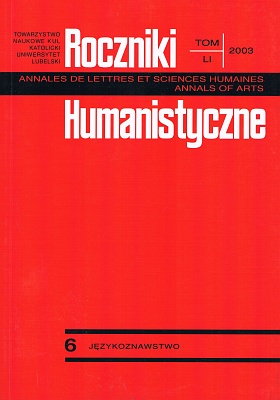Akcent prozodyczny i melodyczny a specjalny status ostatniej sylaby w walijskim
Abstrakt
A closer investigation of patterns of accentuation in Welsh allows to draw a number of conclusions concerning stress models in the language, namely, that there appear to be two types of metrical foot: metrical foot proper (trochaic), defining the prosodic accent, and melodic (tonic) foot (iambic), responsible for the presence of High Tone in its strong branch. These two models are not in conflict but together contribute to the observed peculiarities of Welsh speech, such as its higher pitch associated with the last syllable of the word, numerous vocalic alternations and apparent irregularities and differences in the degree of prosodic stress.
Bibliografia
Buczak M., (2000), Empty Nuclei Fillers in Irish and Welsh, Lublin, mps BKUL.
Buczek A., (1998), The vowel that cannot be long: the story of the Welsh central vowel [K]”, w: Cyran E. (ed.), Structure and Interpretation. Studies in Phonology, Lublin: Wydawnictwo Folium, 55-64.
Griffen, T. D., (1979), On phonological stress in Welsh, “The Bulletin of the Board of Celtic Studies”, XXVIII, 206-212.
Morris-Jones J., (1913), A Welsh Grammar: Historical and Comparative, Oxford: Clarendon Press.
Oftedal M., (1969), “Word Tones” in Welsh?, w: Tilegnet Carl Hj. Borgstr/m. Et festskrift pa 60-arsolagen 12,101969 fra hans elever, Oslo: Universitetforlaget, 119-127.
Pilch H., (1975), Advanced Welsh Phonemics, “Zeitschrift fur Celtische Philologie” 34, 60-102.
Russell P., (1995), An Introduction to the Celtic Languages, London: Longman.
Watkins T. A., (1961), Ieithydiaeth, Ceardydd: Gwasg Prifysgol Cymru.
Watkins T. A., (1974), The accent in Old Welsh – its quality and development, “The Bulletin of the Board of Celtic Studies”XXV, 1-11.
Copyright (c) 2003 Roczniki Humanistyczne

Utwór dostępny jest na licencji Creative Commons Uznanie autorstwa – Użycie niekomercyjne – Bez utworów zależnych 4.0 Międzynarodowe.





